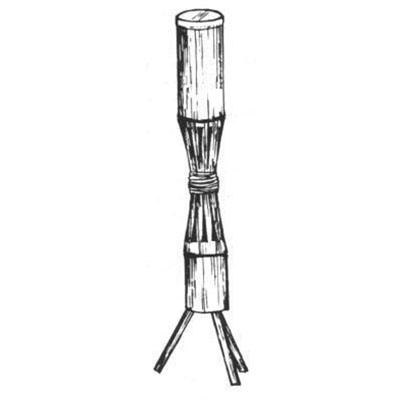zhugu overview
 Bamboo drum (pinyin: Zhú gǔ), also known as bamboo drum, rising drum. Wa, Blang, Dai, Han and other nationalities play the membrane-sounding instruments. In the Awa Mountains in the southwestern border of the motherland, almost every household has bamboo drums for children to play and entertain. Widely popular in Cangyuan, Gengma, Ximeng, Menglian, Lancang, Dehong and other places in Yunnan Province.
Bamboo drum (pinyin: Zhú gǔ), also known as bamboo drum, rising drum. Wa, Blang, Dai, Han and other nationalities play the membrane-sounding instruments. In the Awa Mountains in the southwestern border of the motherland, almost every household has bamboo drums for children to play and entertain. Widely popular in Cangyuan, Gengma, Ximeng, Menglian, Lancang, Dehong and other places in Yunnan Province.Bamboo drums have been used as musical instruments since the Zhou Dynasty. In the Zhou Dynasty, there were eight tones, and the bamboo drum was the leader of the group. The cultural connotation of the bamboo drum was broad and profound. The majestic drum sound closely accompanies the human beings. The vulgar can be the gongs and drums of folk celebration, and the elegant can enter the temple for sacrifice and the court banquet. From primitive pottery drums, earth drums, leather drums, and bronze drums to a wide variety of modern drums, drums are one of the most popular and widely used musical instruments. There is a view that the earliest drums should have been used by ancient ancestors, and evolved from pottery pots, pots and other living utensils. The manufacture of pottery drums has already begun. The pottery drum, also known as the earth drum, is made of pottery clay fired into a drum frame and then covered with animal leather. In China, the tradition of making pottery drums with tiles as the frame has been followed for a long time. Waist drums were introduced into China from the Western Regions and were widely popular in the Tang Dynasty. In addition to wood materials, the waist drums of the Tang Dynasty also used ceramics as drum materials.
The earliest bamboo drum was a bamboo-made sounding instrument made of a large dragon bamboo tube. Later, it was covered with pig bladders, frog skins or snake skins. The Dai people in Dehong call the bamboo drum the pig urine bubble drum. The Lancang Bulang people call bamboo drums earth drums or earth drums, and its use is closely related to customs and activities. In the past, in the year when there was no rain for a long time, according to the traditional folk customs, the whole village held religious prayers for rain and sacrifices. Most of the time, a 30-centimeter-deep round pit was dug under the big green trees on the hillside outside the village, and a bamboo drum was placed in the village. In the pit, there is a table in front of the pit for food such as chicken, wine, and glutinous rice. In the late 1970s, after the transformation and development of musicians in Cangyuan Wa Autonomous County, the drum waist and drum feet were extended at the lower end of the drum shell, so that it could be played on the spot.
- Pinyin:Zhú gǔ
- alias:Bamboo drum, ascending drum
- nationality:Wa, Brown, Dai, Han, etc.
- category:Membrane musical instrument
overview of other similar instruments
- sanyanxiao overview
- Daguangxian overview
- Leiqin overview
- hahao overview
- yandundagu overview
- Han Xiaozheng overview
- Fang Xiang overview
- guanzi overview
- zhuqin (Dao Qin) overview
- zhuiqin overview
- bangzi overview
- three-stringed piano overview
- Gehu overview
- xiao overview
- xiaokonghou overview
- Konghou overview
- Sheng overview
- suona overview
- hulusi overview
- gushao overview
 渝公网安备 50010702504639号
渝公网安备 50010702504639号